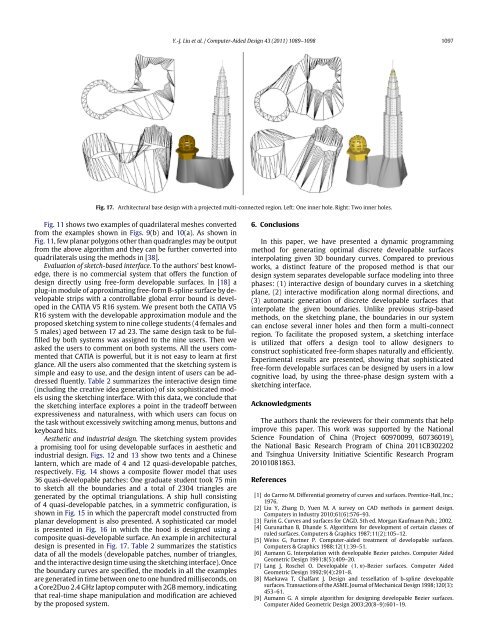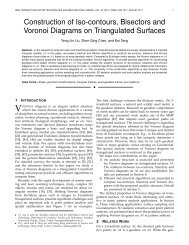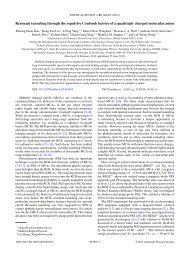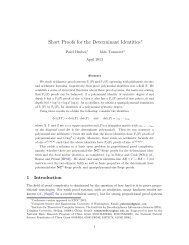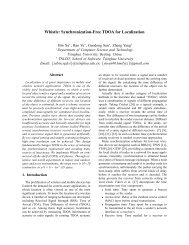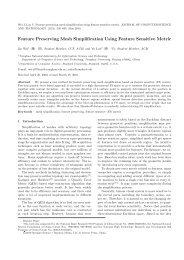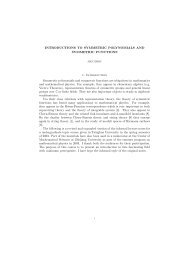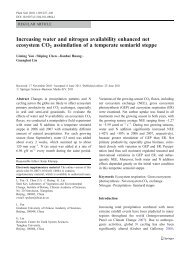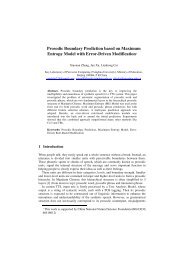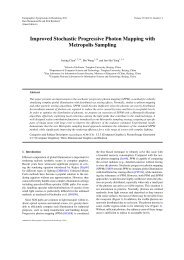Industrial design using interpolatory discrete developable surfaces
Industrial design using interpolatory discrete developable surfaces
Industrial design using interpolatory discrete developable surfaces
You also want an ePaper? Increase the reach of your titles
YUMPU automatically turns print PDFs into web optimized ePapers that Google loves.
Y.-J. Liu et al. / Computer-Aided Design 43 (2011) 1089–1098 1097Fig. 17. Architectural base <strong>design</strong> with a projected multi-connected region. Left: One inner hole. Right: Two inner holes.Fig. 11 shows two examples of quadrilateral meshes convertedfrom the examples shown in Figs. 9(b) and 10(a). As shown inFig. 11, few planar polygons other than quadrangles may be outputfrom the above algorithm and they can be further converted intoquadrilaterals <strong>using</strong> the methods in [38].Evaluation of sketch-based interface. To the authors’ best knowledge,there is no commercial system that offers the function of<strong>design</strong> directly <strong>using</strong> free-form <strong>developable</strong> <strong>surfaces</strong>. In [18] aplug-in module of approximating free-form B-spline surface by <strong>developable</strong>strips with a controllable global error bound is developedin the CATIA V5 R16 system. We present both the CATIA V5R16 system with the <strong>developable</strong> approximation module and theproposed sketching system to nine college students (4 females and5 males) aged between 17 ad 23. The same <strong>design</strong> task to be fulfilledby both systems was assigned to the nine users. Then weasked the users to comment on both systems. All the users commentedthat CATIA is powerful, but it is not easy to learn at firstglance. All the users also commented that the sketching system issimple and easy to use, and the <strong>design</strong> intent of users can be addressedfluently. Table 2 summarizes the interactive <strong>design</strong> time(including the creative idea generation) of six sophisticated models<strong>using</strong> the sketching interface. With this data, we conclude thatthe sketching interface explores a point in the tradeoff betweenexpressiveness and naturalness, with which users can focus onthe task without excessively switching among menus, buttons andkeyboard hits.Aesthetic and industrial <strong>design</strong>. The sketching system providesa promising tool for <strong>using</strong> <strong>developable</strong> <strong>surfaces</strong> in aesthetic andindustrial <strong>design</strong>. Figs. 12 and 13 show two tents and a Chineselantern, which are made of 4 and 12 quasi-<strong>developable</strong> patches,respectively. Fig. 14 shows a composite flower model that uses36 quasi-<strong>developable</strong> patches: One graduate student took 75 minto sketch all the boundaries and a total of 2304 triangles aregenerated by the optimal triangulations. A ship hull consistingof 4 quasi-<strong>developable</strong> patches, in a symmetric configuration, isshown in Fig. 15 in which the papercraft model constructed fromplanar development is also presented. A sophisticated car modelis presented in Fig. 16 in which the hood is <strong>design</strong>ed <strong>using</strong> acomposite quasi-<strong>developable</strong> surface. An example in architectural<strong>design</strong> is presented in Fig. 17. Table 2 summarizes the statisticsdata of all the models (<strong>developable</strong> patches, number of triangles,and the interactive <strong>design</strong> time <strong>using</strong> the sketching interface). Oncethe boundary curves are specified, the models in all the examplesare generated in time between one to one hundred milliseconds, ona Core2Duo 2.4 GHz laptop computer with 2GB memory, indicatingthat real-time shape manipulation and modification are achievedby the proposed system.6. ConclusionsIn this paper, we have presented a dynamic programmingmethod for generating optimal <strong>discrete</strong> <strong>developable</strong> <strong>surfaces</strong>interpolating given 3D boundary curves. Compared to previousworks, a distinct feature of the proposed method is that our<strong>design</strong> system separates <strong>developable</strong> surface modeling into threephases: (1) interactive <strong>design</strong> of boundary curves in a sketchingplane, (2) interactive modification along normal directions, and(3) automatic generation of <strong>discrete</strong> <strong>developable</strong> <strong>surfaces</strong> thatinterpolate the given boundaries. Unlike previous strip-basedmethods, on the sketching plane, the boundaries in our systemcan enclose several inner holes and then form a multi-connectregion. To facilitate the proposed system, a sketching interfaceis utilized that offers a <strong>design</strong> tool to allow <strong>design</strong>ers toconstruct sophisticated free-form shapes naturally and efficiently.Experimental results are presented, showing that sophisticatedfree-form <strong>developable</strong> <strong>surfaces</strong> can be <strong>design</strong>ed by users in a lowcognitive load, by <strong>using</strong> the three-phase <strong>design</strong> system with asketching interface.AcknowledgmentsThe authors thank the reviewers for their comments that helpimprove this paper. This work was supported by the NationalScience Foundation of China (Project 60970099, 60736019),the National Basic Research Program of China 2011CB302202and Tsinghua University Initiative Scientific Research Program20101081863.References[1] do Carmo M. Differential geometry of curves and <strong>surfaces</strong>. Prentice-Hall, Inc.;1976.[2] Liu Y, Zhang D, Yuen M. A survey on CAD methods in garment <strong>design</strong>.Computers in Industry 2010;61(6):576–93.[3] Farin G. Curves and <strong>surfaces</strong> for CAGD. 5th ed. Morgan Kaufmann Pub.; 2002.[4] Gurunathan B, Dhande S. Algorithms for development of certain classes ofruled <strong>surfaces</strong>. Computers & Graphics 1987;11(2):105–12.[5] Weiss G, Furtner P. Computer-aided treatment of <strong>developable</strong> <strong>surfaces</strong>.Computers & Graphics 1988;12(1):39–51.[6] Aumann G. Interpolation with <strong>developable</strong> Bezier patches. Computer AidedGeometric Design 1991;8(5):409–20.[7] Lang J, Roschel O. Developable (1, n)-Bezier <strong>surfaces</strong>. Computer AidedGeometric Design 1992;9(4):291–8.[8] Maekawa T, Chalfant J. Design and tessellation of b-spline <strong>developable</strong><strong>surfaces</strong>. Transactions of the ASME. Journal of Mechanical Design 1998;120(3):453–61.[9] Aumann G. A simple algorithm for <strong>design</strong>ing <strong>developable</strong> Bezier <strong>surfaces</strong>.Computer Aided Geometric Design 2003;20(8–9):601–19.


